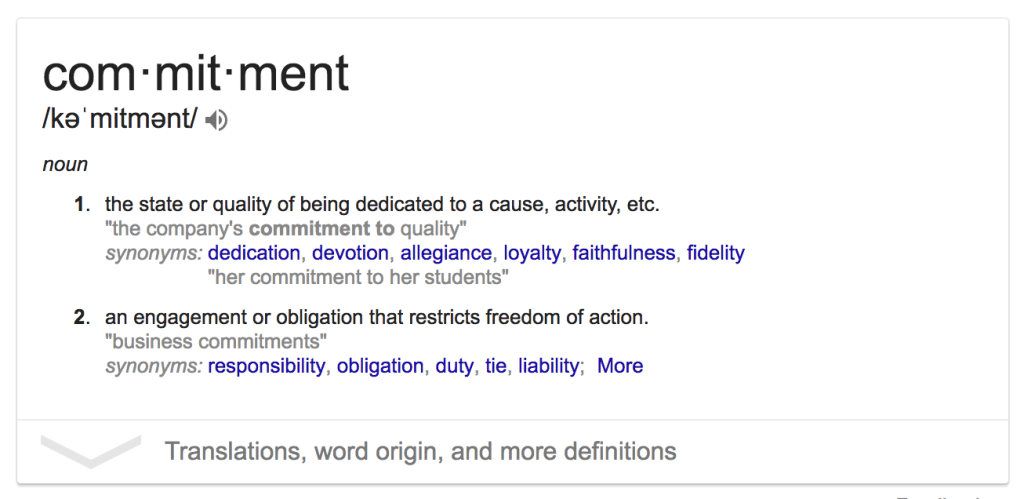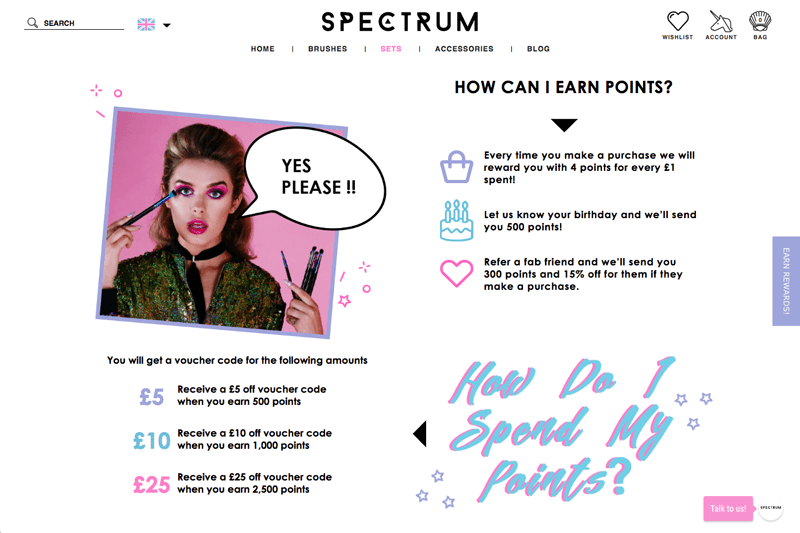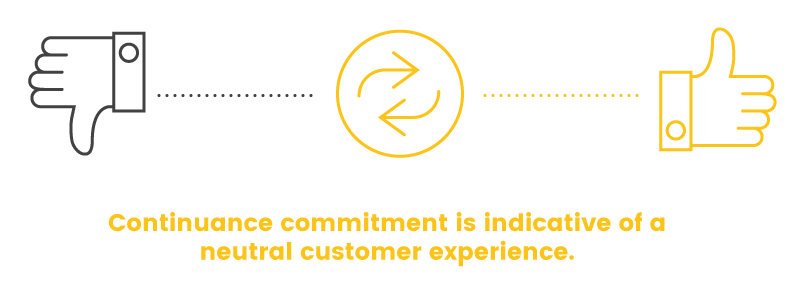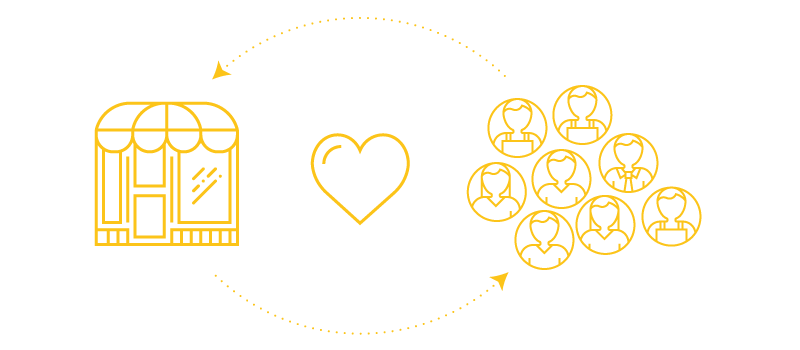You don’t have to look much further than the different definitions of commitment to see that, depending on the context, the word can mean very different things.

With different ideas of what it means, it can be difficult to figure out the exact nature of commitment customers share with the brands that they interact with on a regular basis.
Sometimes, commitment can be a very positive force. It symbolizes dedication and devotion to something or someone. When commitment is viewed in this light, it is both positive and inspiring. The second definition, however, paints a very different picture. Here commitment is viewed as an obligation and a limitation. Something that “restricts freedom of action”
To help explain the different kinds of customer commitment, it’s helpful to borrow from John Meyer and Natalie Allen who outlined the three components of commitment and how they affect organizations. Meyer and Allen focus primarily on employees and their commitment to the organizations they work for but their work can teach us a lot about customer relationships as well.

According to Allen and Meyer, commitment is broken into three different types: affective, continuance, and normative. Each style creates a unique relationship with a customer and encourages them to stay with the brand for very different reasons. You can think of affective, continuance, and normative commitments as coming from dedication, situations, and obligation respectively.
Affective Commitment is Inspired by Dedication
Affective commitment is the style most closely related to the positive definitions of commitment discussed earlier. In simple terms, affective commitment means that customers are staying with a brand because they want to. Of the three styles of motivation it is by far the strongest and when achieved, affective commitment creates customer relationships that grow stronger and last longer.

The term “affective commitment” comes from the root “affect”, which is the experience or feeling of emotion. Consequently, customers who experience affective commitment to a brand tend to be very emotionally invested in the business behind the products they love. They identify personally with the brand and sometimes regard it as a close friend or an extension of themselves.

Affective commitment inspires more than just loyalty – it creates brand advocates. These are customers who go above and beyond to represent the brand to the people around them. Consumers that are committed to a brand in this way are almost completely insulated from competitive offerings because their feelings for the brand make them very difficult to lure away.
How to Create Affective Commitment
While there are many ways a brand can nurture affective customer commitment,customer satisfaction isn’t one of them. Just satisfying your customers is very unlikely to instill the emotional response that is the hallmark of affective commitment. Brands need to move past satisfaction and into customer delight in order to reap the benefits of affective commitment.
Luckily, this type of delight comes in many shapes and forms. Adding some personalization to your customer experience, focusing on world class customer support, or even offering a well designed rewards program can be excellent drivers of customer delight.

In fact, a rewards program is one of the most predominant delight strategies today’s best brands are investing in. From Starbucks’ My Starbucks Rewards to Sephora’s VIB program there are many examples of rewards being used to delight customers. Rewards help put the “custom” back in customer experience by treating each shopper like the individual that they are. This distinction is what develops affective commitment and the advocacy that goes along with it.
Continuance Commitment is Created By A Situation
The second kind of commitment is continuance commitment, and the line between this and affective commitment can be easy to blur. A good way to differentiate the two is that while affective commitment occurs because a customer wants to remain with a brand, continuance commitment happens when a customer feels like they should remain with a brand.

To illustrate the difference between the two, think about a student contemplating their future and considering the opportunities they might want to pursue. The student may genuinely have a passion and a desire to engage in marketing (an affective commitment) but may feel like they should consider a career in finance for the competitive compensation in that industry (continuance commitment).

The issue here is that, like the marketing maven stuck behind a financial statement, continuance commitments are uninspiring. Customers who find themselves in a state of continuance are in a relationship with a brand that involves their head but not their hearts.
These relationships may last for a while but they will usually fail to prompt brand advocacy or any of the other benefits that come with affective commitments. These customers may engage in repeat purchases and might even become loyal customers, but valuable behaviours like referrals are a stretch for them. Additionally, they are much more susceptible to competitive offerings that can match the value your brand provides.
How to Create Continuance Commitment
Continuance commitments are built on customer satisfaction which is created by meeting a customer’s needs and expectations. Exceeding these expectations creates an affective commitment and failing to satisfy will result in a normative commitment. In this way, continuance commitments represent the middle ground – a customer relationship that could be better but could definitely be worse.

Brands can use many savvy business tactics to create continuance customer commitments. Competitive pricing, industry leading features, and other temporary incentives are just a few examples of ways a brand can secure this kind of commitment from its customers.
While it can be fairly easy to lock-in continuance commitments, it is not necessarily in a brand’s best interest. Take mobile service providers, for example. These telecom companies offer everything from free trial months to free phones to sell a customer a plan.

The thing to keep in mind though, is that very few customers actually build a relationship with these brands based on a special promotion alone. As is often the case with continuance relationships, when the promotion ends, the commitment ends because customers think with their heads but commit with their hearts.
Normative Commitment is a Result of Obligation
The last of our commitment components is normative commitment and, as you may have already guessed, it is the least desirable of the three styles. Instead of a customer staying because they want to or because they feel they should, normative commitment is what happens when a customer remains with a brand because they feel they have to.

Returning to our example of the student, while they may want to explore some careers and may feel like they should consider other ones, the law dictates that the student must remain in school until they are 16. Normative commitments arise from a sense of obligation.
The problem with normative commitments is that, like the student waiting to get out of school, their effects are temporary at best. Normative customer commitments often result from current circumstances leaving a customer with little or no choice.

Like continuance commitments, normative commitments will never inspire value driving behaviours like brand advocacy or positive word of mouth. The difference here is normative commitments can actually cause customers to harbour very strong and very negative feelings about the brand because they feel like they are unable to disassociate from it.
The Danger of Normative Commitment
Normative commitments can be created by strict contracts, cancellation penalties, monopolies or oligopolies. These factors create a sense of obligation that should remind you a lot of the second definition of “commitment” from the search result earlier: “an engagement or obligation that restricts freedom of action”.

Brands should try whenever possible to avoid a normative commitment because customers who are normatively committed to a brand can be more trouble than they are worth. As soon as the circumstances that are creating the commitment are gone, the customer will be as well. Secondly, the negative feelings that often accompany these commitments can spill out in conversations with peer groups and can seriously damage the reputation of a brand.
Even if your brand is the only option for a customer (think monopoly or contractual agreement) strive to make the reason for their commitment to you affective,or at the very least, continuance.
Commitment is a Two Way Street
As you can see, a customer’s commitment to a brand is a function of the brand’s commitment back to the customer. Commitment is a reciprocal relationship and investing in your customers will make them more likely to invest in you.

The way a brand builds relationships with its customers will affect how those customers view the brand in return. The difference between an individual seeing interacting with a brand as something they want to, should, or have to do can make all the difference in how they engage with and promote that brand. In short, building effective (or maybe affective) customer relationships is a goal worth committing to.







